The Potential and Utilization of Unused Energy Sources for Large-Scale Horticulture Facility Applications under Korean Climatic Conditions
Abstract
:1. Introduction
1.1. Purposes
1.2. Methods and Scope
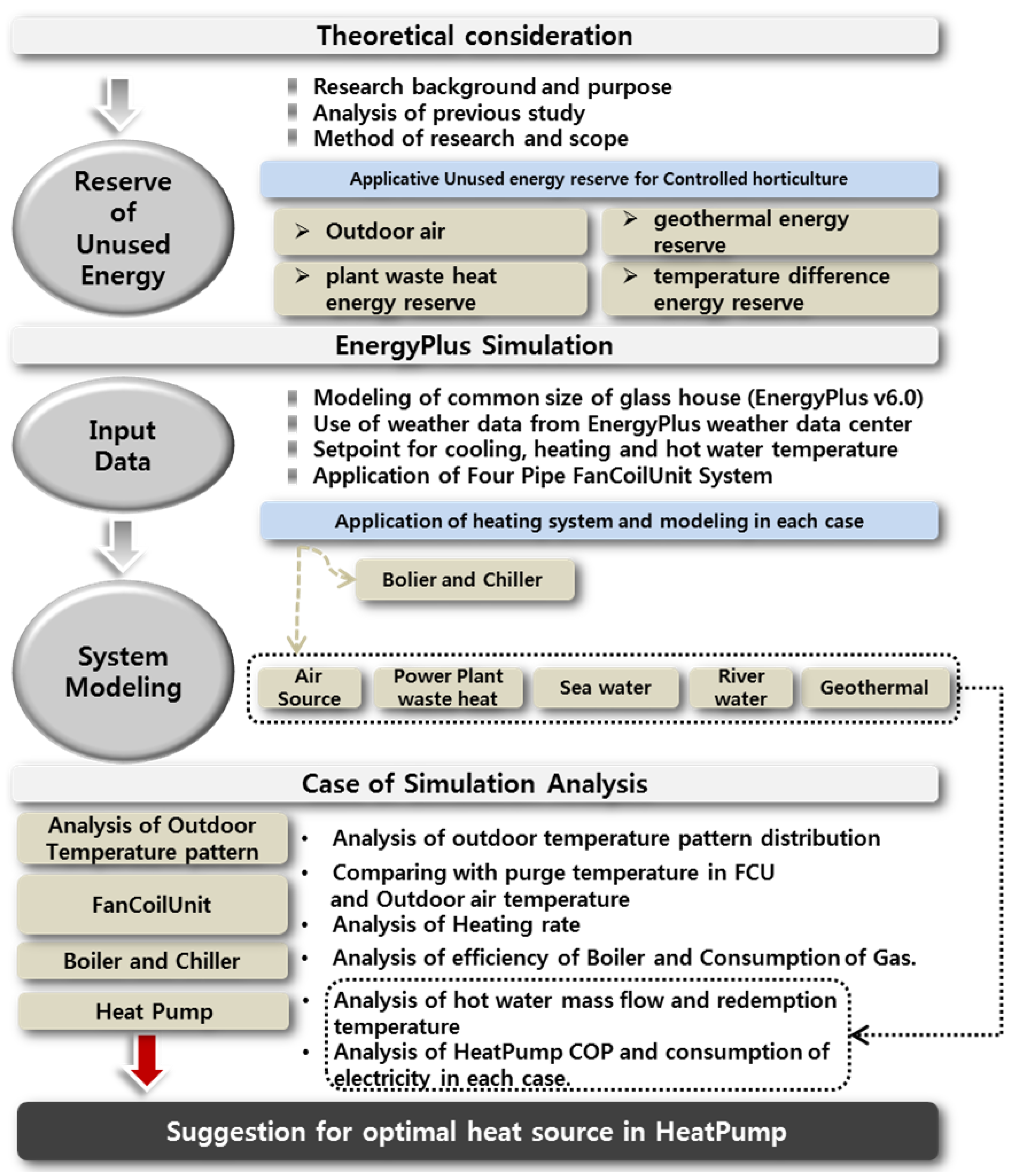
2. Unused Energy Reserves
2.1. Overview of Unused Energy Source Types
| Source | Medium | Utilization Method | Heat Source Temperature Range (°C) |
|---|---|---|---|
| River water | water | heat source for heat pump, cooling water | 0–10 |
| Sea water | water | heat source for heat pump, cooling water | 3–8 |
| Groundwater | water | heat source for heat pump, cooling water | 4–15 |
| Wastewater plant | raw wastewater | heat source for heat pump | >10 |
| treated water | heat source for heat pump | ||
| digestion gas | power generation and heat supply | ||
| sludge | power generation and heat supply | ||
| Waste incinerator | hot gas | heat recovery through vapor, power generation and heat supply | 15–30 |
| hot water (condenser for power generation) | heat source for heat pump, direct use | ||
| Atmosphere | air | heat source for heat pump | −10–15 |
| Exhaust air | air | heat source for heat pump | 15–25 |
| Factories, etc. | hot gas | heat recovery through vapor power generation and heat supply | 10–80 |
| hot water | heat source for heat pump, direct use | ||
| LNG thermal energy | power generation, air liquefaction, etc. | ||
| Electric power plants (condenser) | hot water | heat source for heat pump, utilization for culturing, etc. | 20–35 |
2.2. Definition of Unused Energy Reserve
2.3. Geothermal Energy Reserve
| Depth Interval | Heat Content in J | Heat Content in GToe | Heat Content in GToe (2%) |
|---|---|---|---|
| 0–1 km | 4.25 × 1021 | 101.1 | 2.0 |
| 0–2 km | 1.67 × 1022 | 398.7 | 8.0 |
| 0–3 km | 3.72 × 1022 | 884.9 | 17.7 |
| 0–4 km | 6.52 × 1022 | 1552.8 | 31.3 |
| 0–5 km | 1.01 × 1023 | 2396.0 | 47.9 |
2.4. Power Plant Hot Waste Water Reserve
| Power Station | Yearly Gross Generation (TWh) | Heated Effluent Outflow (×10−1 Billion Ton) | |
|---|---|---|---|
| West coast | West Incheon | 8.8 | 4.6 |
| Incheon | 0.3 | 2.2 | |
| New Incheon | 12.2 | 8.7 | |
| Posco Incheon | 2.4 | 1.9 | |
2.5. Temperature Difference Energy Reserves
2.5.1. Sea Water Heat Energy Reserve


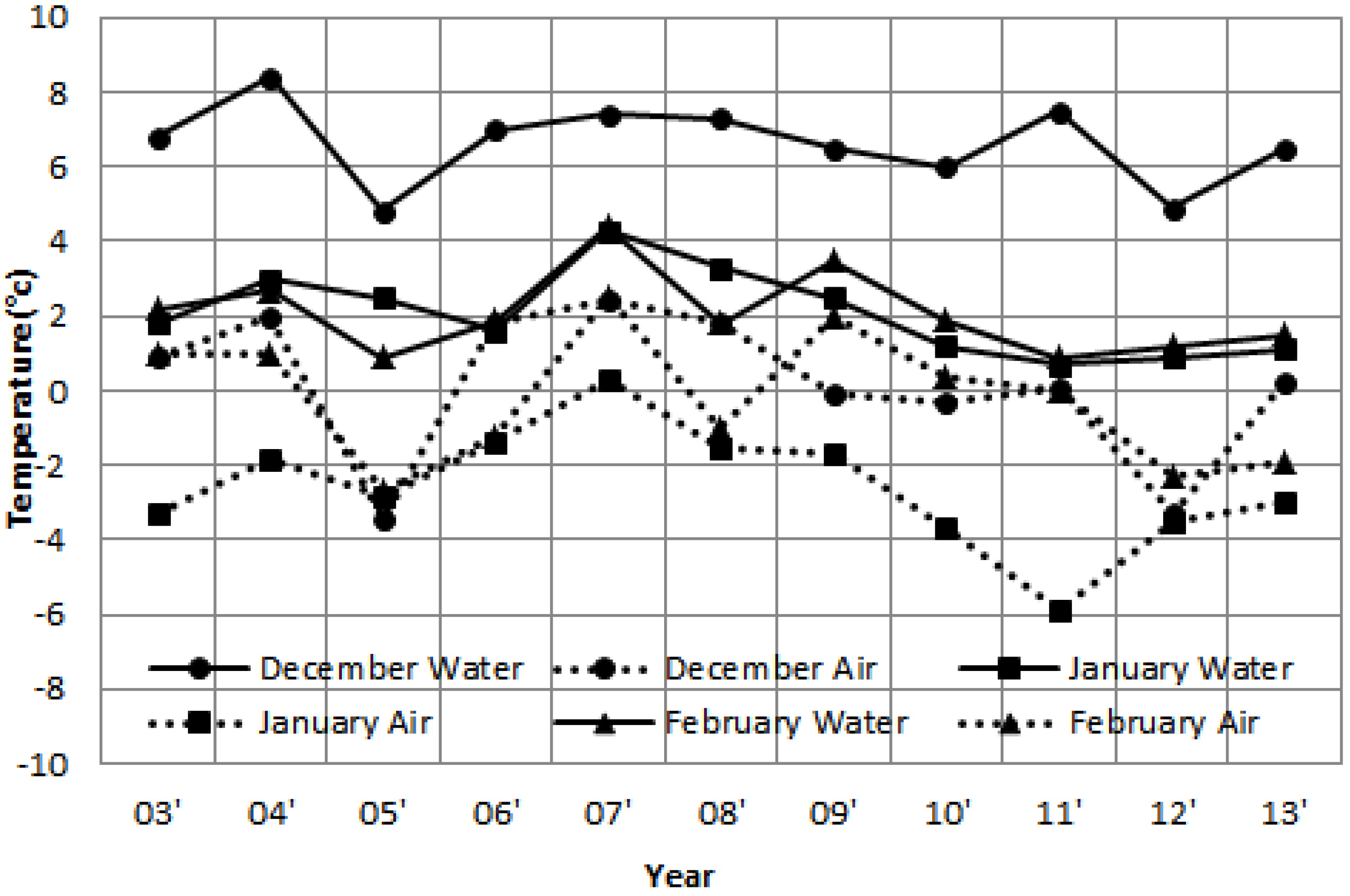
| Region | Effective Coastal Line Length (km) | Average Water Depth within 1 km Distance from the Coast (m) | Reserve (Tcal/year) | Available Heat Energy (Tcal/year) |
|---|---|---|---|---|
| Incheon Metropolitan City (Including Yeongjong Island) | 23.7 66.4 | 10 4 | 5844 | 4457 |
2.5.2. River Water Heat Energy Reserve
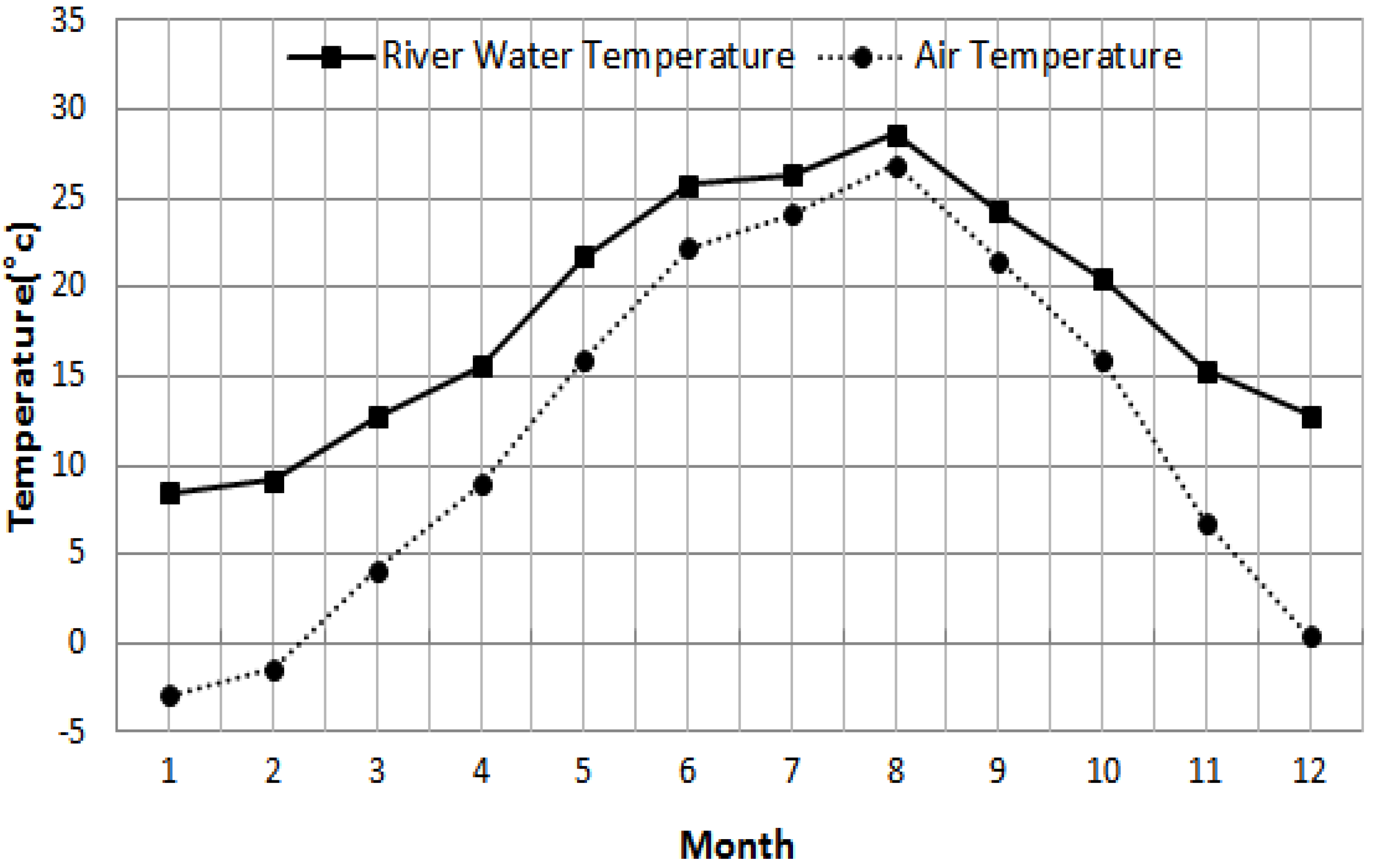
| Region | Flow Rate (m3/s) | Reserve (Tcal/Year) | Available Energy (Tcal/Year) |
|---|---|---|---|
| Seoul | 387.71 | 60,485 | 513 |
| Incheon, Gyeonggi | 178.92 | 28,318 | 237 |
| Total | 566.63 | 88,803 | 750 |
3. Methods
3.1. Simulation Software
3.2. Description of the Simulated Greenhouse

| Property | Input Data |
|---|---|
| Width | 5.6 cm |
| Thermal conductivity | 58 W/m3 |
| Density | 7850 kg/m3 |
| Specific heat | 465 J/kgK |
3.3. HVAC System, Ventilation Rate and Indoor Set-Points
3.4. Plant Modeling


3.5. Simulated Cases
| Case | Terminal Unit at Greenhouse | Heating/Cooling Equipment | Heat Source |
|---|---|---|---|
| 1 | Fan coil unit | Boiler/Centrifugal chiller | N.A. |
| 2 | Fan coil unit | Heat pump | Outdoor air (aerothermal energy) |
| 3 | Fan coil unit | Heat pump | Waste water from power plant |
| 4 | Fan coil unit | Heat pump | Sea water (hydrothermal energy) |
| 5 | Fan coil unit | Heat pump | River (hydrothermal energy) |
| 6 | Fan coil unit | Heat pump | Groundwater (geothermal energy) |
4. Simulation Analysis
4.1. Analysis of Outdoor Air Temperature
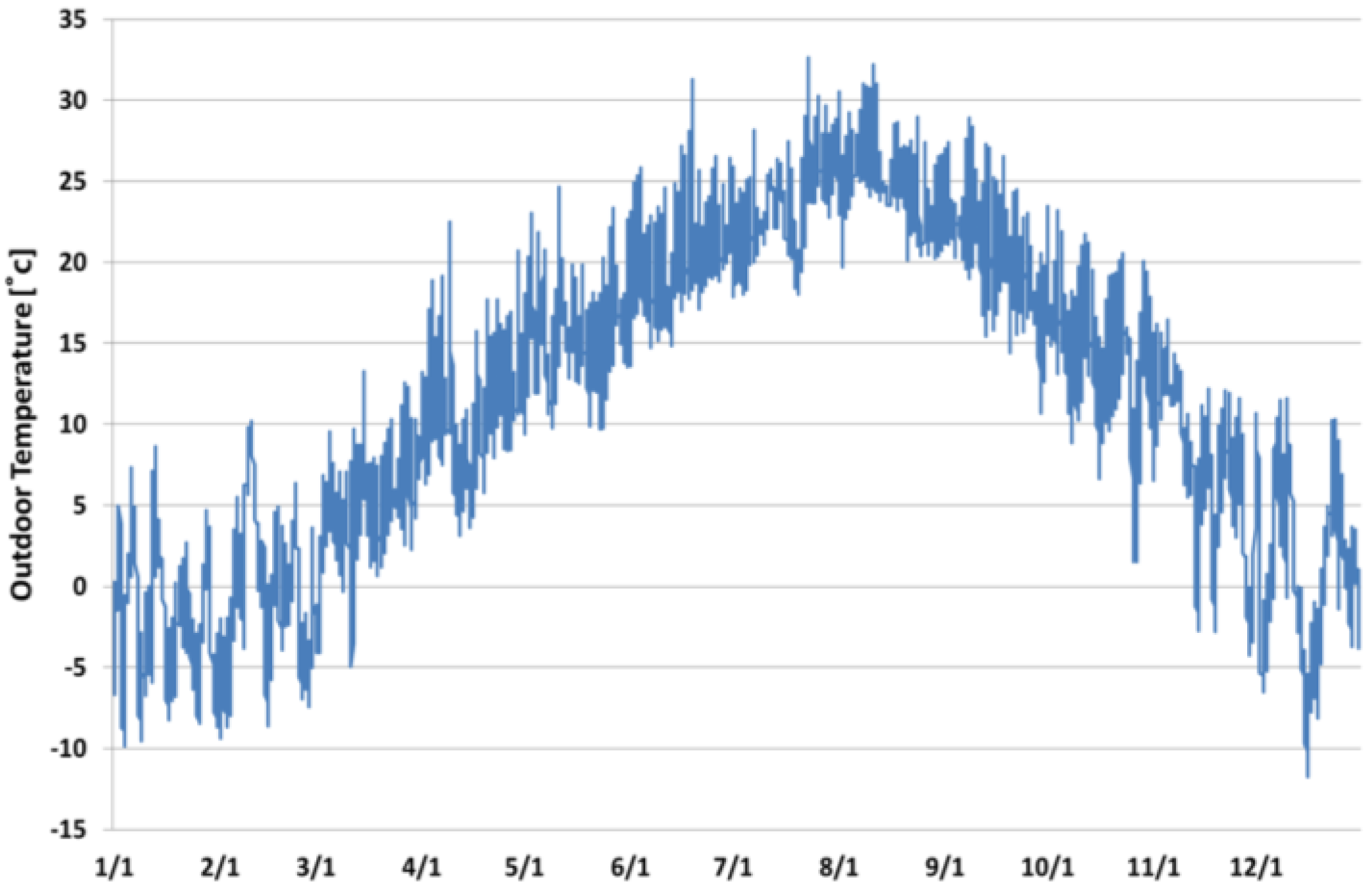
4.2. Comparative Analysis of FCU Air Discharge Temperature and the Outdoor Air Temperature
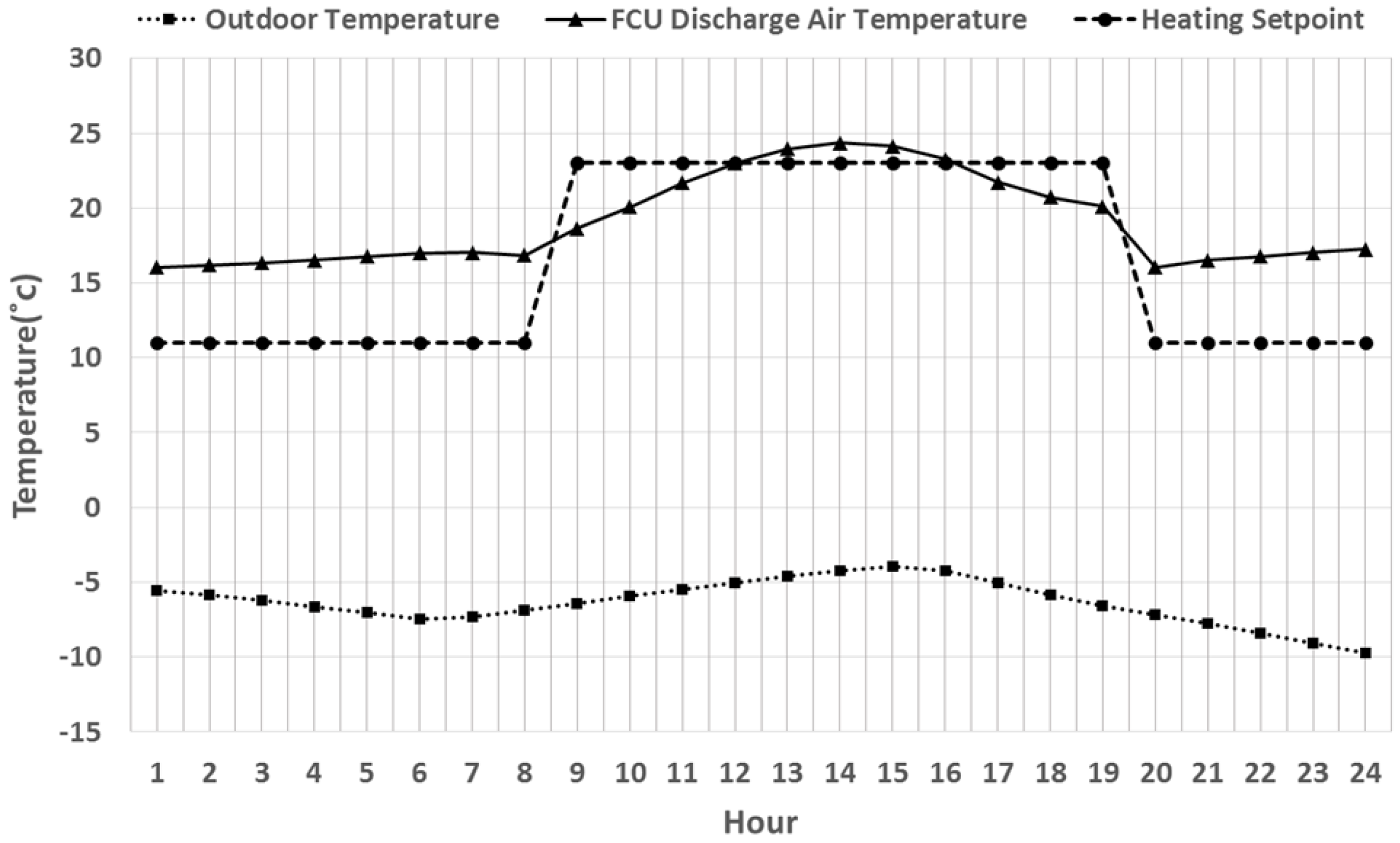
4.3. Analysis Return Water Temperature through FCU and Hot Water Flow Rate

4.4. Analysis of Heat Flow Rate Supplied to the FCU
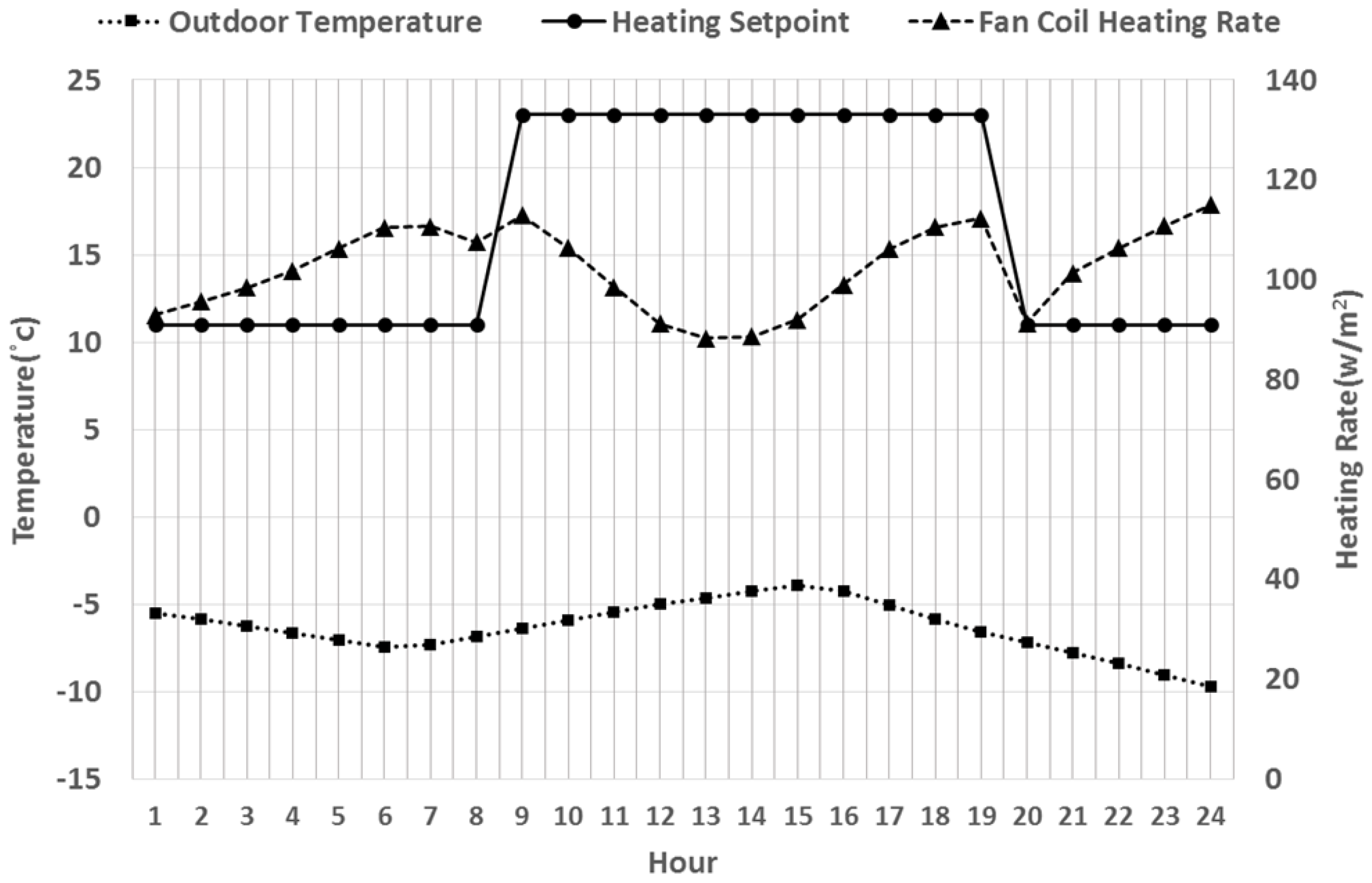
4.5. Heat Pump COP and Boiler Efficiency of Each Heat Source
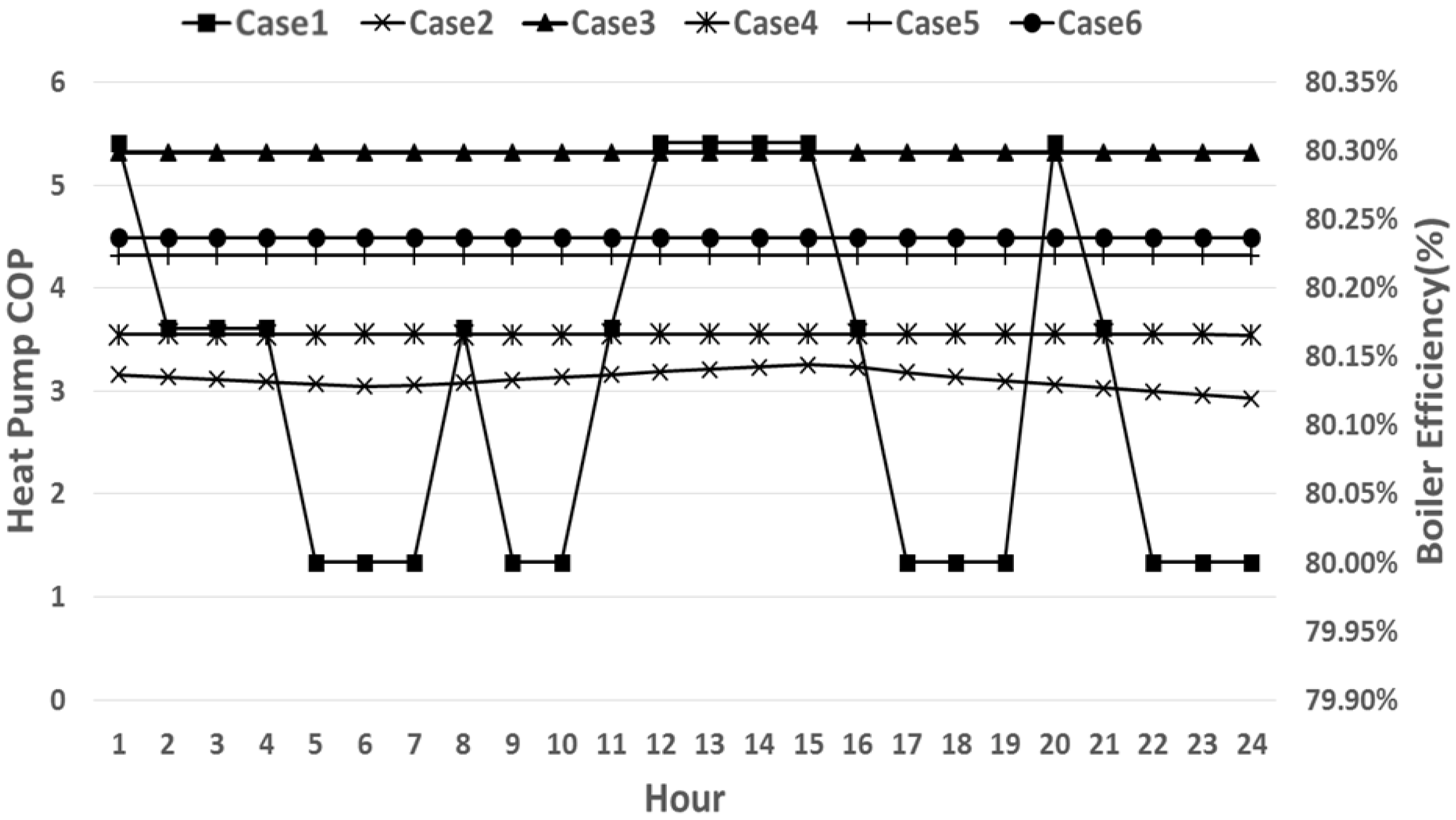
4.6. Comparative Analysis of Gas and Electricity Consumption for Each Heat Source
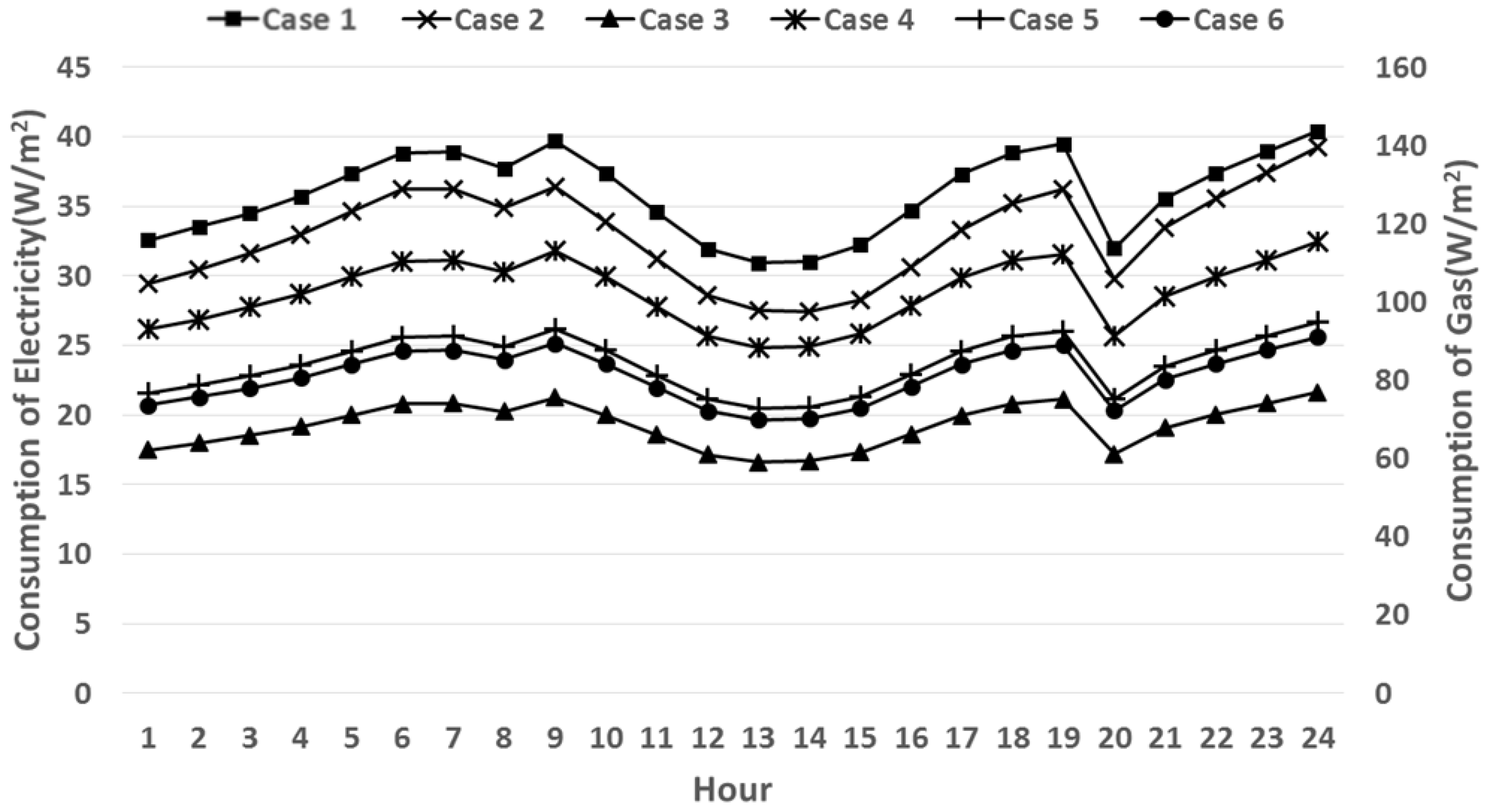
4.7. Comparative Analysis of Gas and Electricity Consumption in Each Month
| Case | January (kWh/m2) | February (kWh/m2) | December (kWh/m2) |
|---|---|---|---|
| Case 1 | 74.8 | 53.1 | 63.3 |
| Case 2 | 18.0 | 12.5 | 14.5 |
| Case 3 | 11.3 | 7.9 | 9.5 |
| Case 4 | 16.7 | 11.7 | 12.7 |
| Case 5 | 13.9 | 9.8 | 9.4 |
| Case 6 | 13.4 | 9.4 | 11.3 |
5. Conclusions
- The subject region of this study was the Incheon region of Korea where the yearly average air temperature was 11.9 °C The coldest day in a year was chosen as the representative day for the analysis. The temperature flowing into the greenhouse from the FCU was in the range of 16.1–24.4 °C. The indoor temperature set point in the greenhouse was 11 °C from 0:00 to 8:00, 23 °C from 9:00 to 19:00, and 11 °C from 20:00 to 24:00. The pattern of the indoor temperature setpoint was similar to that of the temperature of the air flowing into the greenhouse.
- The hot water flow rate to the FCU was dependent on the indoor temperature setpoint and the supplied hot water temperature. Since the temperature of the supplied hot water was constant at 40 °C, the hot water flow rate was dependent on the indoor temperature setpoint. Therefore, the flow rate was high during the daytime when the indoor temperature setpoint was high, and the flow rate pattern was similar to the outdoor air temperature variation pattern during the night time. This may be because much heat was lost through the glass when the outdoor air temperature was low. Since the returned hot water temperature after heat exchange was varied by the flow rate, the returned hot water temperature variation pattern was similar to that of the flow rate.
- The heat flow rate supplied to the FCU was higher when the outdoor air temperature was lower, since heat loss through the glass was increased during the night time although the indoor temperature setpoint was low. During the daytime, despite the higher indoor temperature setpoint, heat was acquired through the glass and thus the required heat quantity was lower than that during the night time. The supplied heat quantity was the lowest as 92 W/m2 at 15:00 when the sunlight was the highest and the outdoor air temperature was the highest during a day, while it was the highest as 114.9 W/m2 at 24:00 when the outdoor air temperature was the lowest during a day.
- The heat pump COP pattern followed the temperature of the analyzed heat sources: the heat pump COP was the highest in the case where power plant waste heat, having the highest temperature, followed by geothermal heat, river water, sea water heat, and outdoor air. The efficiency of the gas boiler, which was the baseline case, was about 80%. The electricity consumption in the case where power plant waste heat was used as a heat source, which had the highest heat source temperature among the cases, was 63.3% to 81.5% lower than that of the case where outdoor air was used as a heat source. The monthly total gas/electricity consumption during January, February, and December when heating was performed was the lowest in the case where power plant waste heat was used as a heat source, as in the energy consumption pattern analyzed above.
Acknowledgments
Author Contributions
Conflicts of Interest
References
- Heo, T. On the Application of the Heat Pump System to Facility Horticulture, Using Hot Waste Water from Power Plants. Ph.D. Thesis, Jeju National University, Jeju, Korea, February 2012. [Google Scholar]
- Yu, Y.S. Development of Greenhouse Cooling & Heating System Using Waste Heat of Thermal Generation Plant; Project No. PJ007432; National Academy of Agricultural Science: Suwon, Korea, 2012. [Google Scholar]
- Ryu, Y.S.; Joo, H.J.; Kim, J.W.; Park, M.R. Economic analysis of cooling-heating system using ground source heat in horticultural greenhouse. J. Korean Sol. Energy Soc. (KSES) 2012, 32, 60–67. [Google Scholar] [CrossRef]
- Park, Y.J. A Study on Field Test of the Horizontal Ground Source Heat Pump System for Greenhouse; 2005-N-GE-P-01; Ministry of Commerce, Industry and Energy (MOTIE): Sejong, Korea, 2007. [Google Scholar]
- Kim, J.S. Efficiency Analysis of Geothermal Heating and Cooling System Using Groundwater for Controlled Horticulture. Ph.D. Thesis, Andong University, Andong, Korea, August 2013. [Google Scholar]
- Baek, Y.J.; Lee, S.H.; Kim, M.S.; Lee, Y.S.; Jang, G.C.; Na, H.S. A simulation study on the annual heating performance of a seawater-source heat pump and air-source heat pump. In Proceedings of the Autumn Conference of the Korean Solar Energy Society (KSES), Seoul, Korea, 1–2 November 2012.
- Fabrizio, E. Energy reduction measures in agricultural greenhouses heating: Envelope, system and solar energy collection. Energy Build. 2012, 53, 57–63. [Google Scholar] [CrossRef]
- Park, J.T.; Jang, G.C. An investigation on quantity of unused energy using temperature difference energy as heat source and its availability. Energy Eng. J. 2002, 11, 106–113. [Google Scholar]
- Moon, J.P. Utilization of river bank filtration for horticulture facility. Korea J. Geotherm. Energy (KSGEE) 2012, 8, 10–14. [Google Scholar]
- Guidance on Energy Efficient Farm Product Management in Greenhouses; Rural Development Administration (RDA): Suwon, Korea, 2011; pp. 2–3.
- Jin, S.H.; Hong, E.J. The Feasibility Analysis of Urban Unused Energy: Focusing on Technology, Institution and Infrastructure; Korea Institute of Ecological Architecture and Environment (KIEAE): Seoul, Korea, 2013. [Google Scholar]
- Jeon, N.S. Guidance for Gyeong Nam Horticulture Facility in the Era of Low Carbon Green Growth; GyeongNam Development Institute: Changwon, Korea, 2009. [Google Scholar]
- Park, J.T.; Jang, G.C. Technology for Utilizing Unused Energy Sources. Korean Assoc. Air Cond. Refrig. Sanit. Eng. (KARSE) 2002, 19, 33–42. [Google Scholar]
- Unused Energy Resources for 21st Century; Department of Economy and Industry of Japan: Tokyo, Japan, 1990.
- Takeshi, K.; Hiroo, T.; Hisashi, M. Possibility of Utilization of River Water as the Heat Source/Sink of Heat-Pump Systems: Part I. In Proceedings of the Annual Conference of Architectural Institute of Japan, Tokyo, Japan, 12–14 September 1993; pp. 499–500.
- Hisashi, M.; Hiroo, T.; Takeshi, K. Possibility of Utilization of River Water as the Heat Source/Sink of Heat-Pump Systems: Part II. In Proceedings of the Annual Conference of Architectural Institute of Japan, Tokyo, Japan, 12–14 September 1993; pp. 501–503.
- Recent Advancement of Unused Energy Resources; Committee of District Energy of Renewable Energy Foundation: Tokyo, Japan, 1992.
- Utilization of Urban Gas for Unused Energy Source Applications; Unused Energy Sources Committee of Japanese Gas Association: Tokyo, Japan, 1991.
- Song, Y.H.; Kim, H.C.; Lee, Y.M.; Lee, T.J. Potential of geothermal energy in Korean peninsula. Soc. Air Cond. Refrig. Eng. Korea (SAREK) 2009, 38, 42–50. [Google Scholar]
- Park, S.H. Geothermal Resource Assessment in Korea. Master’s Thesis, Kongju University, Kongju, Korea, August 2008. [Google Scholar]
- Blackwell, D.D.; Negraru, P.T.; Richards, M.C. Assessment of the enhanced geothermal system resource base of the United States. Nat. Resour. Res. 2007, 15, 283–308. [Google Scholar] [CrossRef]
- Muffler, P.; Cataldi, R. Methods for regional assessment of geothermal resources. Geothermics 1978, 7, 53–89. [Google Scholar] [CrossRef]
- Tester, J.W.; Anderson, B.; Batchelor, A.; Blackwell, D.; DiPippo, R.; Drake, E.; Garnish, J.; Livesay, B.; Moore, M.C.; Nichols, K.; et al. The Future of Geothermal Energy: Impact of Enhanced Geothermal Systems (EGS) on the United States in the 21st Century; DOE Contract DE-AC07–05ID 14517 Final Report; Massachusetts Institute of Technology: Cambridge, MA, USA, 2006. [Google Scholar]
- Jo, J.H.; Kim, D.Y.; Lee, J.S. Directions for Developing Green Aquaculture Using Thermal Effluent from Power Plant; Korea Maritime Institute: Seoul, Korea, 2010. [Google Scholar]
- Yu, Y.S. Heat exchanger design of a heat pump system using the heated effluent of thermal power generation plant as a heat source for greenhouse heating. J. Bio-Environ. Control (KSBEC) 2012, 21, 372–378. [Google Scholar] [CrossRef]
- Electric Power Statistics Information System (EPSIS). Available online: https://epsis.kpx.or.kr (accessed on 28 February 2014).
- Lee, J.H.; Hyun, I.T.; Yoon, Y.B.; Lee, K.H. Investigation of Reserves and Potentials of Unused Energy Sources for Large-scale Horticulture Facility Applications. In Proceedings of the Summer Conference of the Society of Air-conditioning and Refrigerating Engineers of Korea, Yong Pyong, Korea, 25–27 June 2014.
- List of Publication of Nautical Charts and Documents; Korea Hydrographic and Oceanographic and Administration: Seoul, Korea, 1996.
- Park, I.H.; Yoon, H.; Park, J.T.; Jang, K.C.; Lee, Y.S. A study on the potential energy reserve amount of domestic river water as unutilized energy resource. Soc. Air-Cond. Refrig. Eng. Korea (SAREK) 2005, 17, 521–528. [Google Scholar]
- Crawley, D.B.; Lawrie, L.K.; Winkelmann, F.C.; Buhl, W.F.; Huang, H.J.; Pedersen, C.O.; Strand, R.K.; Liesen, R.J.; Fisher, D.E.; Witte, M.J.; et al. EnergyPlus: Creating a new-generation building energy simulation program. Energy Build. 2001, 33, 319–331. [Google Scholar] [CrossRef]
- ASHRAE Fundamentals Handbook; American Society of Heating, Refrigerating and Air-Conditioning Engineers, Inc.: Atlanta, GA, USA, 2009.
- EnergyPlus. Testing and Validation. Available online: http://apps1.eere.energy.gov/buildings/energyplus/testing.cfm (accessed on 28 February 2014).
- Standard Test Method for Determining Air Leakage Rate by Fan Pressurization; Active Standard No. ASTM E 779–87; American Society for Testing and Materials (ASTM): West Conshohocken, PA, USA, 1987.
- Kim, K.S.; Yoon, J.H.; Song, I.C. Energy performance evaluation of heat reflective radiant barrier systems for greenhouse night insulation. Archit. Inst. Korea (AIK) 2000, 16, 153–161. [Google Scholar]
- The USA DOE, 2012. EnergyPlus Input Output Reference. The Encyclopedic Reference to EnergyPlus Input and Output. Available online: http://apps1.eere.energy.gov/buildings/energyplus/pdfs/inputoutputreference.pdf (accessed on 28 April 2014).
- EnergyPlus, 2014. EnergyPlus Engineering Reference. The Reference to EnergyPlus Calculations. Available online: http://apps1.eere.energy.gov/buildings/energyplus/pdfs/engineeringreference.pdf (accessed on 28 April 2014).
- Nam, Y.; Ooka, R.; Shiba, Y. Development of dual-source heat pump system using groundwater and air. Energy Build. 2010, 42, 909–916. [Google Scholar] [CrossRef]
- Nam, Y.; Ooka, R. Numerical simulation of ground heat and water transfer for groundwater heat pump system based on real-scale experiment. Energy Build. 2010, 42, 69–75. [Google Scholar] [CrossRef]
© 2014 by the authors; licensee MDPI, Basel, Switzerland. This article is an open access article distributed under the terms and conditions of the Creative Commons Attribution license (http://creativecommons.org/licenses/by/3.0/).
Share and Cite
Hyun, I.T.; Lee, J.H.; Yoon, Y.B.; Lee, K.H.; Nam, Y. The Potential and Utilization of Unused Energy Sources for Large-Scale Horticulture Facility Applications under Korean Climatic Conditions. Energies 2014, 7, 4781-4801. https://doi.org/10.3390/en7084781
Hyun IT, Lee JH, Yoon YB, Lee KH, Nam Y. The Potential and Utilization of Unused Energy Sources for Large-Scale Horticulture Facility Applications under Korean Climatic Conditions. Energies. 2014; 7(8):4781-4801. https://doi.org/10.3390/en7084781
Chicago/Turabian StyleHyun, In Tak, Jae Ho Lee, Yeo Beom Yoon, Kwang Ho Lee, and Yujin Nam. 2014. "The Potential and Utilization of Unused Energy Sources for Large-Scale Horticulture Facility Applications under Korean Climatic Conditions" Energies 7, no. 8: 4781-4801. https://doi.org/10.3390/en7084781




